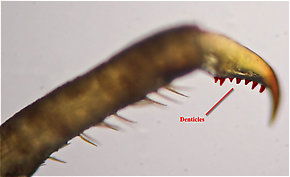Blog & Latest Updates
Fly Fishing Articles
Insects by Common Name


> > Mystery Creek # 199
About "Mystery Creeks": I love small streams, but some of my favorite little trout streams are too small and too fragile to publicize here. If you recognize one of these, you already understand why I'm keeping it a secret. These are the kinds of places that lose a little bit of their charm if you see someone else's week-old footprint, and I don't want to do that to them.
Closeup insects from Mystery Creek # 199
Male Serratella micheneri (Little Western Dark Hendrickson) Mayfly Nymph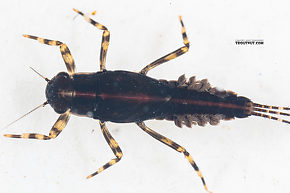 View 9 PicturesThis specimen has tarsal claws (Tarsal claw: The claws at the tip of the tarsus, on an insect's "foot.") with 7 denticles (Denticle: Small tooth-like projects, often appearing like serrations on the tarsal claws of certain mayfly nymphs.) and tubercles (
View 9 PicturesThis specimen has tarsal claws (Tarsal claw: The claws at the tip of the tarsus, on an insect's "foot.") with 7 denticles (Denticle: Small tooth-like projects, often appearing like serrations on the tarsal claws of certain mayfly nymphs.) and tubercles (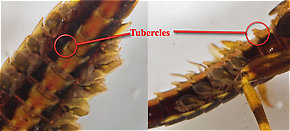 Tubercle: Various peculiar little bumps or projections on an insect. Their character is important for the identification of many kinds of insects, such as the nymphs of Ephemerellidae mayflies.) on abdominal segments 4-7 only. It keys to Serratella micheneri, as do some other specimens from the same collection that lacked the dorsal (Dorsal: Top.) stripe.
Tubercle: Various peculiar little bumps or projections on an insect. Their character is important for the identification of many kinds of insects, such as the nymphs of Ephemerellidae mayflies.) on abdominal segments 4-7 only. It keys to Serratella micheneri, as do some other specimens from the same collection that lacked the dorsal (Dorsal: Top.) stripe.
 View 9 PicturesThis specimen has tarsal claws (Tarsal claw: The claws at the tip of the tarsus, on an insect's "foot.") with 7 denticles (Denticle: Small tooth-like projects, often appearing like serrations on the tarsal claws of certain mayfly nymphs.) and tubercles (
View 9 PicturesThis specimen has tarsal claws (Tarsal claw: The claws at the tip of the tarsus, on an insect's "foot.") with 7 denticles (Denticle: Small tooth-like projects, often appearing like serrations on the tarsal claws of certain mayfly nymphs.) and tubercles (
A few (not all) of the abdominal tubercles on this Ephemerella needhami nymph are circled. They are especially large in this species.
Collected July 28, 2019 from Mystery Creek #199 in Washington
Added to Troutnut.com by Troutnut on July 30, 2019
Added to Troutnut.com by Troutnut on July 30, 2019
Female Suwallia pallidula (Sallfly) Stonefly Adult View 9 PicturesI collected a few of these throughout the afternoon. The positive ID on the adults allowed me to also put a species ID on the nymphs.
View 9 PicturesI collected a few of these throughout the afternoon. The positive ID on the adults allowed me to also put a species ID on the nymphs.
 View 9 PicturesI collected a few of these throughout the afternoon. The positive ID on the adults allowed me to also put a species ID on the nymphs.
View 9 PicturesI collected a few of these throughout the afternoon. The positive ID on the adults allowed me to also put a species ID on the nymphs.Collected July 28, 2019 from Mystery Creek #199 in Washington
Added to Troutnut.com by Troutnut on July 29, 2019
Added to Troutnut.com by Troutnut on July 29, 2019
Chironomidae (Midges) Midge Larva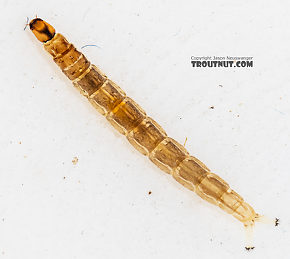 View 7 PicturesThis relatively large, olive-colored midge larva was very abundant in my samples from this little creek in the mountains.
View 7 PicturesThis relatively large, olive-colored midge larva was very abundant in my samples from this little creek in the mountains.
 View 7 PicturesThis relatively large, olive-colored midge larva was very abundant in my samples from this little creek in the mountains.
View 7 PicturesThis relatively large, olive-colored midge larva was very abundant in my samples from this little creek in the mountains.Collected July 28, 2019 from Mystery Creek #199 in Washington
Added to Troutnut.com by Troutnut on July 30, 2019
Added to Troutnut.com by Troutnut on July 30, 2019
Serratella micheneri (Little Western Dark Hendrickson) Mayfly Nymph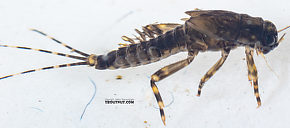 View 6 Pictures
View 6 Pictures
 View 6 Pictures
View 6 PicturesCollected July 28, 2019 from Mystery Creek #199 in Washington
Added to Troutnut.com by Troutnut on July 30, 2019
Added to Troutnut.com by Troutnut on July 30, 2019
Rhyacophila (Green Sedges) Caddisfly Pupa View 3 PicturesThis was a neat, rare view into a Rhyacophila caddisfly just beginning to pupate, with the features of the larva still clearly visible inside.
View 3 PicturesThis was a neat, rare view into a Rhyacophila caddisfly just beginning to pupate, with the features of the larva still clearly visible inside.
 View 3 PicturesThis was a neat, rare view into a Rhyacophila caddisfly just beginning to pupate, with the features of the larva still clearly visible inside.
View 3 PicturesThis was a neat, rare view into a Rhyacophila caddisfly just beginning to pupate, with the features of the larva still clearly visible inside.Collected July 28, 2019 from Mystery Creek #199 in Washington
Added to Troutnut.com by Troutnut on July 30, 2019
Added to Troutnut.com by Troutnut on July 30, 2019
Male Drunella coloradensis (Small Western Green Drake) Mayfly Spinner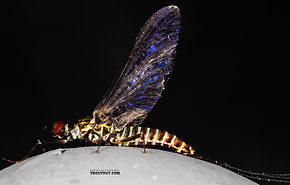 View 9 PicturesThis spinner molted from this dun, or possibly one other dun I had in the same container that looked just like it.
View 9 PicturesThis spinner molted from this dun, or possibly one other dun I had in the same container that looked just like it.
 View 9 PicturesThis spinner molted from this dun, or possibly one other dun I had in the same container that looked just like it.
View 9 PicturesThis spinner molted from this dun, or possibly one other dun I had in the same container that looked just like it.Collected July 28, 2019 from Mystery Creek #199 in Washington
Added to Troutnut.com by Troutnut on July 30, 2019
Added to Troutnut.com by Troutnut on July 30, 2019
Drunella coloradensis (Small Western Green Drake) Mayfly Nymph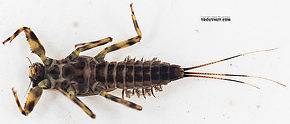 View 5 Pictures
View 5 Pictures
 View 5 Pictures
View 5 PicturesCollected July 28, 2019 from Mystery Creek #199 in Washington
Added to Troutnut.com by Troutnut on July 30, 2019
Added to Troutnut.com by Troutnut on July 30, 2019
Ameletus (Brown Duns) Mayfly Nymph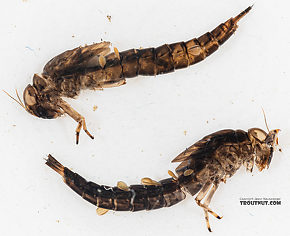 View 2 PicturesThese two exuviae are my sad little consolation prize after collecting a couple of really cool, large, mature mayfly nymphs I didn't recognize from a tiny, probably fishless, spring-fed tributary of a slightly less tiny trout stream. I saw the nymphs in the kicknet samples and carefully transferred each one to my holding cooler before going to collect more samples. When I got home, I carefully went through the whole sample and couldn't find either one of them. Getting worried, I did it again and even more carefully. This time, I found both exuviae. By process of elimination, pretty much the only possibility is that both of them hatched out of my cooler and flew away during the 10 minutes or so that I had the lid off to collect more samples.
View 2 PicturesThese two exuviae are my sad little consolation prize after collecting a couple of really cool, large, mature mayfly nymphs I didn't recognize from a tiny, probably fishless, spring-fed tributary of a slightly less tiny trout stream. I saw the nymphs in the kicknet samples and carefully transferred each one to my holding cooler before going to collect more samples. When I got home, I carefully went through the whole sample and couldn't find either one of them. Getting worried, I did it again and even more carefully. This time, I found both exuviae. By process of elimination, pretty much the only possibility is that both of them hatched out of my cooler and flew away during the 10 minutes or so that I had the lid off to collect more samples.
I was really excited about them for the whole three-hour drive home and seriously bummed that they disappeared. In the field I thought they might be one of the families of swimmer nymphs I don't have yet, like Ametropodidae, but keying the exuviae takes me to Ameletus, so at least I didn't miss some great rarity. Still, they were much larger and darker than any other Ameletus I've collected and probably a species I don't have yet.
 View 2 PicturesThese two exuviae are my sad little consolation prize after collecting a couple of really cool, large, mature mayfly nymphs I didn't recognize from a tiny, probably fishless, spring-fed tributary of a slightly less tiny trout stream. I saw the nymphs in the kicknet samples and carefully transferred each one to my holding cooler before going to collect more samples. When I got home, I carefully went through the whole sample and couldn't find either one of them. Getting worried, I did it again and even more carefully. This time, I found both exuviae. By process of elimination, pretty much the only possibility is that both of them hatched out of my cooler and flew away during the 10 minutes or so that I had the lid off to collect more samples.
View 2 PicturesThese two exuviae are my sad little consolation prize after collecting a couple of really cool, large, mature mayfly nymphs I didn't recognize from a tiny, probably fishless, spring-fed tributary of a slightly less tiny trout stream. I saw the nymphs in the kicknet samples and carefully transferred each one to my holding cooler before going to collect more samples. When I got home, I carefully went through the whole sample and couldn't find either one of them. Getting worried, I did it again and even more carefully. This time, I found both exuviae. By process of elimination, pretty much the only possibility is that both of them hatched out of my cooler and flew away during the 10 minutes or so that I had the lid off to collect more samples. I was really excited about them for the whole three-hour drive home and seriously bummed that they disappeared. In the field I thought they might be one of the families of swimmer nymphs I don't have yet, like Ametropodidae, but keying the exuviae takes me to Ameletus, so at least I didn't miss some great rarity. Still, they were much larger and darker than any other Ameletus I've collected and probably a species I don't have yet.
Collected July 28, 2019 from Mystery Creek #199 in Washington
Added to Troutnut.com by Troutnut on July 30, 2019
Added to Troutnut.com by Troutnut on July 30, 2019
Start a Discussion of Mystery Creek # 199:
Top 10 Fly Hatches
Top Gift Shop Designs
Eat mayflies.
Top Insect Specimens
Miscellaneous Sites
Troutnut.com is copyright © 2004-2024 Jason
Neuswanger (email Jason). See my FAQ for information about use of my images.
 privacy policy
privacy policy

